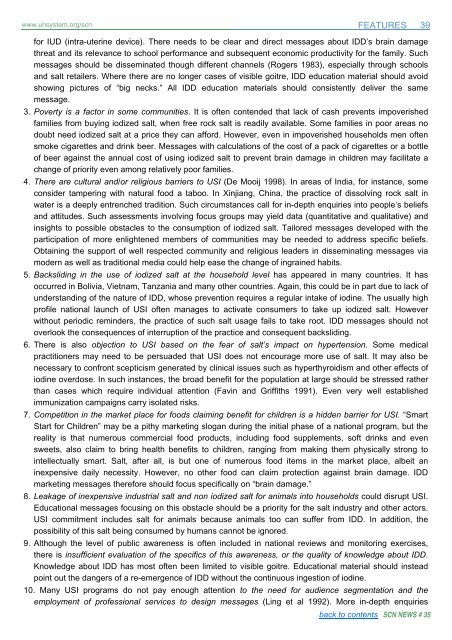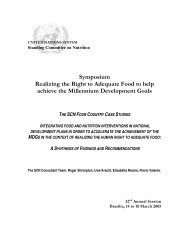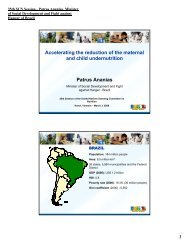Universal Salt Iodization (USI) - FTP Directory Listing
Universal Salt Iodization (USI) - FTP Directory Listing
Universal Salt Iodization (USI) - FTP Directory Listing
- No tags were found...
Create successful ePaper yourself
Turn your PDF publications into a flip-book with our unique Google optimized e-Paper software.
www.unsystem.org/scn FEATURES 39for IUD (intra-uterine device). There needs to be clear and direct messages about IDD’s brain damagethreat and its relevance to school performance and subsequent economic productivity for the family. Suchmessages should be disseminated though different channels (Rogers 1983), especially through schoolsand salt retailers. Where there are no longer cases of visible goitre, IDD education material should avoidshowing pictures of “big necks.” All IDD education materials should consistently deliver the samemessage.3. Poverty is a factor in some communities. It is often contended that lack of cash prevents impoverishedfamilies from buying iodized salt, when free rock salt is readily available. Some families in poor areas nodoubt need iodized salt at a price they can afford. However, even in impoverished households men oftensmoke cigarettes and drink beer. Messages with calculations of the cost of a pack of cigarettes or a bottleof beer against the annual cost of using iodized salt to prevent brain damage in children may facilitate achange of priority even among relatively poor families.4. There are cultural and/or religious barriers to <strong>USI</strong> (De Mooij 1998). In areas of India, for instance, someconsider tampering with natural food a taboo. In Xinjiang, China, the practice of dissolving rock salt inwater is a deeply entrenched tradition. Such circumstances call for in-depth enquiries into people’s beliefsand attitudes. Such assessments involving focus groups may yield data (quantitative and qualitative) andinsights to possible obstacles to the consumption of iodized salt. Tailored messages developed with theparticipation of more enlightened members of communities may be needed to address specific beliefs.Obtaining the support of well respected community and religious leaders in disseminating messages viamodern as well as traditional media could help ease the change of ingrained habits.5. Backsliding in the use of iodized salt at the household level has appeared in many countries. It hasoccurred in Bolivia, Vietnam, Tanzania and many other countries. Again, this could be in part due to lack ofunderstanding of the nature of IDD, whose prevention requires a regular intake of iodine. The usually highprofile national launch of <strong>USI</strong> often manages to activate consumers to take up iodized salt. Howeverwithout periodic reminders, the practice of such salt usage fails to take root. IDD messages should notoverlook the consequences of interruption of the practice and consequent backsliding.6. There is also objection to <strong>USI</strong> based on the fear of salt’s impact on hypertension. Some medicalpractitioners may need to be persuaded that <strong>USI</strong> does not encourage more use of salt. It may also benecessary to confront scepticism generated by clinical issues such as hyperthyroidism and other effects ofiodine overdose. In such instances, the broad benefit for the population at large should be stressed ratherthan cases which require individual attention (Favin and Griffiths 1991). Even very well establishedimmunization campaigns carry isolated risks.7. Competition in the market place for foods claiming benefit for children is a hidden barrier for <strong>USI</strong>. “SmartStart for Children” may be a pithy marketing slogan during the initial phase of a national program, but thereality is that numerous commercial food products, including food supplements, soft drinks and evensweets, also claim to bring health benefits to children, ranging from making them physically strong tointellectually smart. <strong>Salt</strong>, after all, is but one of numerous food items in the market place, albeit aninexpensive daily necessity. However, no other food can claim protection against brain damage. IDDmarketing messages therefore should focus specifically on “brain damage.”8. Leakage of inexpensive industrial salt and non iodized salt for animals into households could disrupt <strong>USI</strong>.Educational messages focusing on this obstacle should be a priority for the salt industry and other actors.<strong>USI</strong> commitment includes salt for animals because animals too can suffer from IDD. In addition, thepossibility of this salt being consumed by humans cannot be ignored.9. Although the level of public awareness is often included in national reviews and monitoring exercises,there is insufficient evaluation of the specifics of this awareness, or the quality of knowledge about IDD.Knowledge about IDD has most often been limited to visible goitre. Educational material should insteadpoint out the dangers of a re-emergence of IDD without the continuous ingestion of iodine.10. Many <strong>USI</strong> programs do not pay enough attention to the need for audience segmentation and theemployment of professional services to design messages (Ling et al 1992). More in-depth enquiriesback to contents SCN NEWS # 35







